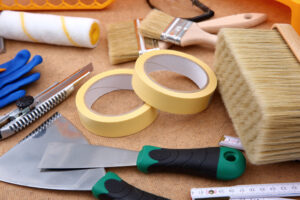At the moment, due to the lesser demand for them, high-performance eco-friendly products tend to carry a marginally higher purchasing cost, but outperform toxic alternatives with longer life-expectency and reduced maintenance, without even needing to weigh in the enormous health benefits for the building’s users.
Most of our competitors are in the mindset of choosing the products and materials with the cheapest initial costs, without concern for much else. This is a fundamentally flawed approach and doesn’t take into account life expectancy, maintenance costs or performance.
Without even going into the health and life-cycle costs, let’s just look at the numbers:
Emulsion
| Conventional | Eco-friendly |
| £ 8.10 per litre | £ 9.12 per litre |
| Only £ 1.02 or +18.5% more per litre |
Solvent based Wood Paint
| Conventional | Eco-friendly |
| £ 9.30 per litre | £ 25.86 per litre |
| A significant £ 16.56 or +178% more per litre |
Water based Wood Paint
| Conventional | Eco-friendly |
| £ 14.00 per litre | £ 9.65 per litre |
| Cheaper by £ 4.35 or 31% less per litre |
Masonry Paint
| Conventional | Eco-friendly |
| £ 6.55 per litre | £ 8.16 per litre |
| Only £ 1.61 or +24.5% more per litre |
As can be seen by calculations, with the exception of the solvent-based woodwork paint, the eco-friendly alternatives are only marginally more expensive, or as in the case of the water-based wood paint, cheaper. We can average the increased cost of using eco products to 47.5%. This average is inflated largely due to the contribution from the solvent-based woodwork paint.
An Example Project Costing
Let’s put this into perspective by looking at an example decorating project costing £1000. On average, materials account for about 15% of the project total.
| Conventional | Eco-Friendly | |
| Labour | £ 850.00 | £ 850.00 |
| Materials | £ 150 | £ 221.25 |
| Total | £ 1000.00 | £ 1071.25 |
| Only £ 71.25 or 7.13% more to be Eco-Friendly! |
We expect eco-friendly products to continue to be cheaper with time as supply and demand increase, and we’ve not even taken into account value for money, health benefits or product life-cycle, which is where much of their value comes.





